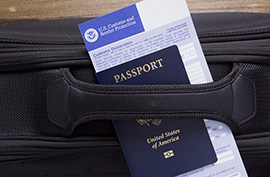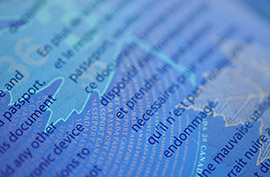 For budding travelers, holding a first passport is almost a magical thing, offering a sense of pure possibility and excitement. It turns out that there are a lot of other magical as well as not so magical things to know about passports in 2016; here is a list of 10 facts you may not know about your passport -- some essential, some just fun.
For budding travelers, holding a first passport is almost a magical thing, offering a sense of pure possibility and excitement. It turns out that there are a lot of other magical as well as not so magical things to know about passports in 2016; here is a list of 10 facts you may not know about your passport -- some essential, some just fun.
In 2005 Congress passed the Real ID Act, which set authentication standards for passports, driver's licenses and other official ID cards. The adoption schedule is a classic bureaucratic tangle involving varied deadlines, extensions and exemptions, but for travelers, the most important piece of information is that you will need Real ID-compliant identification to fly domestically starting January 22, 2018.
If you have a driver's license, you'd think you would be okay, but the sticking point is that not all states have adopted the new standards yet, and if your driver's license has been issued by one of those states, you will need some other form of conforming ID. Thus, many U.S. citizens will be forced to get passports if their state does not update its licenses. Here is the current status of compliance and adoption by state.
This is just one reason passport applications will likely go up in the next year or two; another is the upcoming anniversary of the Western Hemisphere Travel Initiative, which in 2007 made it mandatory to carry a passport for any air travel between the U.S. and Bermuda, Canada, the Caribbean and Mexico. This resulted in a large number of new and renewed passports being issued in 2006 and 2007 -- all of which will be up for renewal this year or next.
The State Department estimates that passport processing times could increase by one-third in 2016 and get even worse after that, so don't get caught in the rush; check your passport status now and get ahead of it.
Your passport has a very clear expiration date, but that doesn't always mean you can travel with it right up to that date. Many countries require that your passport be valid for a specified time after you arrive; this is to ensure that you don't let your passport expire while in the country, stranding you there.
Some countries require that your passport be valid for 90 days after entry, including most European countries governed by the Schengen Act, but a safer rule of thumb is six months, which is the length of time required by China, Indonesia, Russia, Saudi Arabia and many other countries.
The State Department has a list of passport validity requirements here, but beware, this information may not tell the whole story. For example, to enter Brazil, the site indicates that your passport must be valid on the date of entry -- but to get a Brazilian visa, your passport needs to be valid for six months beyond the date of entry.
 Learn How to Get or Renew a U.S. Passport
Learn How to Get or Renew a U.S. Passport
Speaking of visas, applying for one can be among the most complicated document transactions you will ever encounter. Many countries have multiple types, including tourist, work, business and student visas, and the application process and turnaround times can vary dramatically for each.
Additionally, some embassies and consulates require appointments to apply for a visa, sometimes with weeks-long wait times, while others may process only visa applications submitted through a third-party agency -- and this can vary not only by country, but by the specific consulate office location. You sometimes need to show plane tickets, a letter of invitation and other documentation.
Add to these issues the fact that many consulates are understaffed, and getting a visa needs your attention well ahead of time. To avoid scrambling or paying expedite fees, start the process at least two or three months before your trip. Remember that you'll have to give up your passport while the visa is being processed, so you'll want to schedule your application around any other international trips you're taking.
If you are living or traveling abroad for an extended period of time, you may need to renew your passport while overseas. The process for this isn't that different from doing so at home, although you will face some of the issues mentioned above, such as the need for an appointment or requirements that applications be mailed and not presented in person. This report from an American living in Paris underscores both the challenges and relative ease of the process.
 For example, what happens when you put a Canadian passport under a black light beats any "70s Show" nostalgia.
For example, what happens when you put a Canadian passport under a black light beats any "70s Show" nostalgia.
The new Norwegian passport -- the design of which was chosen from a public competition -- shows the northern lights when you put it under a UV light.
And the U.S. passport has some 30 different security features at work; meanwhile, the current Nicaraguan passport has 89 such features.
Speaking of technology used to verify passports, the history of passport and passport forgery is surprisingly interesting. For example, back in the 1700s wood block prints with a coat of arms were actually a pretty good anti-forgery tactic, as hiring a woodcarver was not a trivial matter, says Martin Lloyd in Fighting the Forger: The Secrets of Your Passport. He also notes that standardized government forms made forgery easier and that watermarks were used in France as early as 1808.
Meanwhile, Wanderlust.co.uk reports that most of Europe dispensed with passports altogether when large numbers of citizens began traveling by rail in the 19th century, but they were brought back during WWI to hamper spies. (Incidentally, the British passport around this time included details such as "shape of face" and the size of your nose, according to the Guardian.)
 Living Like a Local: Expat Interviews from Around the World
Living Like a Local: Expat Interviews from Around the World
Passport photos have notoriously stringent requirements; in the U.S., the photo must measure two inches by two inches, with your head measuring between 1 and 1.375 inches. That means you can't just snap a picture at home against the refrigerator and print it out at Target. The State Department also notes that "hand-held self portraits are not acceptable."
The passport expeditor ItsEasy is trying to help change that, however; its passport application app now includes a mechanism to take a selfie that the company will use on your passport application.
Many passport (and especially visa) counters do not accept walk-in applications without an appointment, and most say that same-day passports are not possible. Anecdotally, however, exceptions happen all the time, as I've seen based on comments from friends, colleagues and Internet strangers. You may find pity from a passport agency worker if you show up and really need help. (Just don't plan around it.)
Probably not your passport, according to analysis done by a travel technology company last year. The most desirable passport, based on a calculation that includes the cost of obtaining it and the extent of visa-free access to other countries, is the Swedish passport -- which costs just $43 and gets you into 174 countries without a visa.
Finally, if your U.S. passport is expired but you really want to travel outside the 50 states, you do have some options; consider visiting a territory of the U.S., where your driver's license will suffice for now. Many of these are very attractive destinations, including Puerto Rico, the U.S. Virgin Islands (St. Croix, St. John and St. Thomas), American Samoa, the Northern Mariana Islands and Guam.
So passport or no passport...
Go Anyway,
Ed Hewitt
Features Editor
IndependentTraveler.com